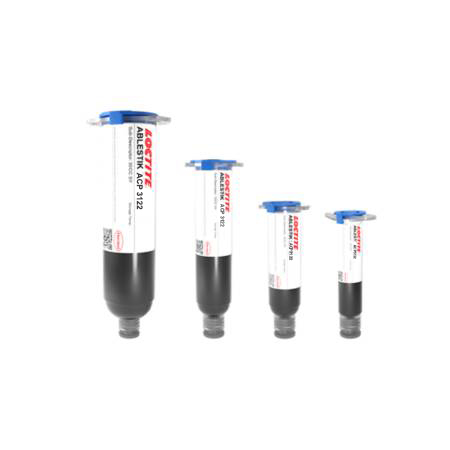LOCTITE ABLESTIK ACP 3122
- Conductive only in z axis
- Anisotropic electrically conductive
- Low temperature cure
Product Description
This product has limited availability for niche applications. It is listed as No longer available but please reach out to us if there is demand for high quantities that cannot be achieved by Film factors.
LOCTITE® ABLESTIK ACP 3122 is an anisotropic epoxy adhesive designed for high throughput microelectronics assembly applications. This adhesive conducts in only one direction, making it suitable for small die and component attachment without the possibility of electrical shorting. ACP-3122 requires pressure during cure to establish a reliable interconnect.
Even though it is listed as an Underfill, LOCTITE® ABLESTIK ACP 3122 can also be used to bond a die, facilitate electrical connections under the bumps and (finally, as an underfill) destress the area around the bumps. So it goes without saying that it is a multi purpose product. Anisotropic pastes & films work well over a limited operating temperature range. If you are looking to operate outside of the range of -40°C/+125°C (or maybe even -40°C/+ 90°C) then there could be some issues with reliability that need to be tested.
Cure Schedule
- 5 seconds @ 150°C under optimum pressure, bondline temperature
LOCTITE ABLESTIK ACP 3122 requires pressure during cure to establish a reliable connection. Most dies up to 1 sq mm in size require a 1 to 3 Newtons to form a reliable interconnect. The optimum pressure is best determined for each new design. The recommended bonding condition for this adhesive is 5 seconds at a bondline temperature of 150ºC. No post cure is required. Material properties will depend upon cure conditions used
Technical Specifications
| General Properties | |||||
| Work life @25°C Work life @25°C Work life is the amount of time we have to work with a material until it is no longer able to be easily worked and applied on a substrate. It is based on the change in viscosity and it can rely on the application requirements. | 24 hours | ||||
| |||||
| Thermal Properties | |||||
| Glass Transition Temperature (Tg) Glass Transition Temperature (Tg) The glass transition temperature for organic adhesives is a temperature region where the polymers change from glassy and brittle to soft and rubbery. Increasing the temperature further continues the softening process as the viscosity drops too. Temperatures between the glass transition temperature and below the decomposition point of the adhesive are the best region for bonding. The glass-transition temperature Tg of a material characterizes the range of temperatures over which this glass transition occurs. | 100 °C | ||||
| Physical Properties | |||||
| Viscosity Viscosity Viscosity is a measurement of a fluid’s resistance to flow. Viscosity is commonly measured in centiPoise (cP). One cP is defined as the viscosity of water and all other viscosities are derived from this base. MPa is another common unit with a 1:1 conversion to cP. A product like honey would have a much higher viscosity -around 10,000 cPs- compared to water. As a result, honey would flow much slower out of a tipped glass than water would. The viscosity of a material can be decreased with an increase in temperature in order to better suit an application | 22,000 mPa.s | ||||



